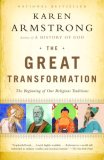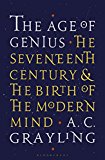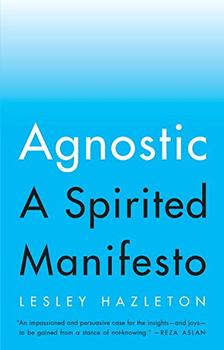Summary | Excerpt | Reading Guide | Reviews | Beyond the book | Read-Alikes | Genres & Themes | Author Bio

Critics' Opinion:
Readers' Opinion:
First Published:
Mar 2006, 496 pages
Paperback:
Apr 2007, 560 pages
 Book Reviewed by:
Book Reviewed by:
BookBrowse Review Team
Buy This Book
From the book
jacket: In the ninth century BCE,
the peoples of four distinct regions of
the civilized world created the
religious and philosophical traditions
that have continued to nourish humanity
to the present day: Confucianism and
Daoism in China, Hinduism and Buddhism
in India, monotheism in Israel, and
philosophical rationalism in Greece.
Later generations further developed
these initial insights, but we have
never grown beyond them. Rabbinic
Judaism, Christianity, and Islam, for
example, were all secondary flowerings
of the original Israelite vision.
Armstrong traces the development of the
Axial Age chronologically, examining the
contributions of such figures as the
Buddha, Socrates, Confucius, Jeremiah,
Ezekiel, the mystics of the Upanishads,
Mencius, and Euripides. All of the Axial
Age faiths began in principled and
visceral recoil from the unprecedented
violence of their time.
Despite some
differences of emphasis, there was a
remarkable consensus in their call for
an abandonment of selfishness and a
spirituality of compassion. With regard
to dealing with fear, despair, hatred,
rage, and violence, the Axial sages gave
their people and give us, Armstrong
says, two important pieces of advice:
first there must be personal
responsibility and self-criticism, and
it must be followed by practical,
effective action.
Comment: Since 1942 the BBC
have broadcast a weekly radio program called
Desert Island Discs in which a
guest chats with the interviewer about
their life and shares the eight pieces of music
that have meant the most to them.
These pieces of music are what will
accompany them to their hypothetical
desert island, along with a book of
their choice and one luxury item. When interviewed on the program
last year
Karen Armstrong chose to be
accompanied to her desert island by a
variety of classic music, the complete
works of Milton and a "continuous supply
of very cold and dry white wine".
If I could take one book to a desert
island, The Great Transformation: The
Beginning of Our Religious Tradition
(subtitled The World in the Time of
Buddha, Socrates, Confucius and Jeremiah
in the UK) would be
high on the list because it's one of
those books that is entertaining to dip
into but also has the depth, scope and
clarity of thinking to stand up to close scrutiny. Armstrong traces the
roots of the Axial age to the Russian
steppes about
1,500 BCE , where the slow movement from nature-worship
and sacrifice to a more inward-looking
and compassionate approach to life began, and
then bounces between the four key Axial
regions, showing at what points they
connect and how they have influenced the
modern-day religions so many hold dear.
She shows us that the shift in spiritual
thinking during the Axial age was not
only radical compared to what had come
before, but also was substantially
different to what many
consider "religion" to be today.
The Axial age thinkers were concerned more with
self-transformation than belief systems,
and questions of theology and
metaphysics were unimportant.
On this basis, Armstrong suggests that
we should not see one or another
doctrine as right or wrong in of itself,
but instead should look for the
spiritual concept that lies at the root
of each to find the commonalities of
compassion and tolerance. Of
course, the idea that we can solve the
world's problems by finding common
ground between religions is hardly a new
idea. However, Armstrong's grasp
of history and her ability to so lucidly
explain it to us raises The Great
Transformation well above the level
of mere platitude.
![]() This review was originally published in The BookBrowse Review in May 2006, and has been updated for the
April 2007 edition.
Click here to go to this issue.
This review was originally published in The BookBrowse Review in May 2006, and has been updated for the
April 2007 edition.
Click here to go to this issue.

If you liked The Great Transformation, try these:

by A.C. Grayling
Published 2017
Out of a 'fractured and fractious time,' the author asserts persuasively, the medieval mind evolved into the modern. Another thought-provoking winner from Grayling." - Kirkus

by Lesley Hazleton
Published 2017
A widely admired writer on religion celebrates agnosticism as the most vibrant, engaging - and ultimately the most honest - stance toward the mysteries of existence.





The Funeral Cryer by Wenyan Lu
Debut novelist Wenyan Lu brings us this witty yet profound story about one woman's midlife reawakening in contemporary rural China.
Your guide toexceptional books
BookBrowse seeks out and recommends the best in contemporary fiction and nonfiction—books that not only engage and entertain but also deepen our understanding of ourselves and the world around us.